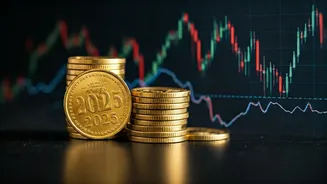Market Overview
The gold market, known for its status as a safe-haven asset, is currently displaying signs of a downward correction. This shift has prompted numerous analysts
to issue warnings regarding a potential pullback. Several factors contribute to these fluctuations, including shifts in investor sentiment, movements in currency values, and changes in global economic conditions. A key element influencing gold prices is the strength of the US dollar; when the dollar gains ground, gold prices often face downward pressure, and vice versa. Furthermore, interest rate decisions made by central banks can also have a significant impact, with rate hikes typically diminishing the appeal of non-yielding assets like gold. The current environment is characterized by uncertainty, as the market is reacting to various global developments, making it essential for investors to stay informed and cautious. This section will give an overview of the global market conditions that impact gold.
Expert Warnings
As gold prices experience a downturn, numerous market experts have voiced their concerns regarding the potential for a pullback. These warnings stem from an analysis of current market dynamics and trends. The prevailing sentiment among these experts is one of caution, urging investors to approach the situation with careful consideration. The experts' advice generally centers on the need for investors to assess their risk tolerance and to consider diversifying their portfolios. They highlight that while gold can serve as a safe haven during times of economic instability, it is not immune to market corrections. Some analysts advise against impulsive decisions, suggesting that investors should not necessarily panic sell but instead conduct thorough due diligence. It is suggested to monitor key economic indicators closely and remain updated on any significant shifts in global monetary policies, as these factors directly impact gold prices. Furthermore, it is important to consult multiple sources and consider diverse perspectives to make well-informed decisions.
Pullback Trends Analyzed
The current trend of gold price decline is a subject of intense scrutiny, with analysts identifying several contributing factors. One key element is the strengthening of the US dollar, which often exerts downward pressure on gold prices. Economic data releases and shifts in investor sentiment are also important. The anticipation of, or actual implementation of, interest rate adjustments by central banks further influences the market. The specific causes behind the pullback include profit-taking by investors, a reduction in safe-haven demand, and shifts in currency exchange rates. Analyzing the historical trends reveals patterns that help predict future market behaviors. A complete analysis of these trends, including examining various economic indicators, will aid in understanding how the market may develop. This section will also examine the overall direction of the market.
Investor Strategies
Given the current volatility in the gold market, investors are advised to adopt prudent strategies. A frequently recommended approach is diversification, ensuring investments are spread across different asset classes to mitigate risks. Careful risk management is crucial, including setting clear investment goals and risk tolerance levels. Investors should also stay informed about market developments by regularly monitoring economic news and expert analysis. Some experts suggest a 'buy the dip' strategy, where investors purchase gold when prices are low, anticipating a future rebound. Consulting with financial advisors is also advised to formulate personalized investment plans. Strategies need to be dynamic, adaptable to the changing market landscape. Ultimately, the best strategy is based on individual circumstances, risk tolerance, and investment goals.
Future Outlook
Looking ahead, the future direction of gold prices remains uncertain, influenced by various global events and economic factors. Key elements that will affect gold's price include shifts in the US dollar's value, policy decisions by central banks, and changes in overall economic growth and stability. Geopolitical events, such as international conflicts and trade tensions, will also play an important role. Many analysts are projecting possible scenarios, ranging from a continued decline in the short term to a potential recovery in the long term. These scenarios are based on various models and historical data, but the market's unpredictable nature means future movements cannot be guaranteed. Investors should maintain a long-term perspective, recognizing that gold's value may fluctuate. Staying informed and adaptable is vital for navigating the gold market.












